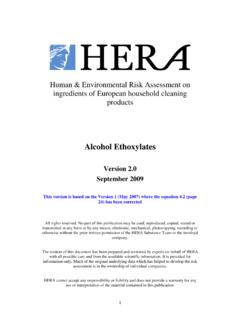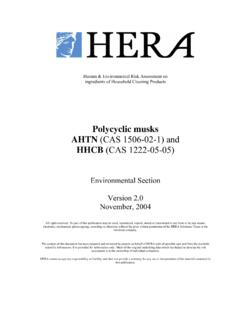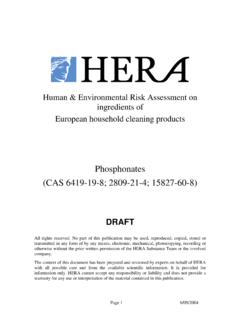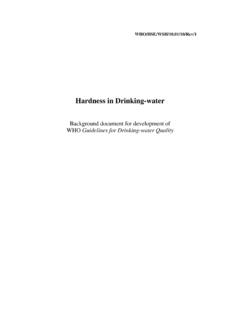Transcription of Polycarboxylates used in detergents (Part I) - HERA …
1 Human & Environmental Risk assessment on ingredients of European household cleaning products Polycarboxylates used in detergents ( part I) Polyacrylic acid homopolymers and their sodium salts (CAS 9003-04-7) January, 2014 Version All rights reserved. No part of this publication may be used , reproduced, copied, stored or transmitted in any form or by any means, electronic, mechanical, photocopying, recording or otherwise without the prior written permission of the HERA Substance Team or the involved company. The content of this document has been prepared and reviewed by experts on behalf of HERA with all possible care and from the available scientific information. It is provided for information only. Much of the original underlying data which has helped to develop the risk assessment is in the ownership of individual companies.
2 HERA cannot accept any responsibility or liability and does not provide a warranty for any use or interpretation of the material contained in this publication. 1 1. EXECUTIVE SUMMARY General Water-soluble linear Polycarboxylates are used in household cleaning products, in laundry detergents , automatic dishwashing detergents and various hard surface-cleaning formulations, and also in institutional and industrial cleaning processes and a variety of technical applications. Polycarboxylates are used in low-phosphate and phosphate-free detergents for avoiding incrustation and soil redeposition. Their effect is not based on complexing properties and therefore not comparable with typical chelating agents. The mechanism is the dispersion of calcium carbonate or calcium phosphate and the suspended solids during washing processes.
3 Major Polycarboxylates used in detergents products comprise two different types of polymer families which distinguish in their technical applications and physical chemical properties: homopolymers of acrylic acid (P-AA) which is described in part I and copolymers of acrylic/maleic acid (P-AA/MA) which is described in part II of the HERA report. For this updated version the European total consumption of homopolymers in detergent applications covered by HERA was updated to 21,000 tons/year in 2011. The mean molecular weight (MW) of the homopolymers P-AA ranges from approximately 1,000 to 78,000. Most investigations have been performed on the most commonly used commercial homopolymers with MW of 4,500. They generally are used in neutralised form (pH 6-8) as their sodium salts.
4 A comprehensive overview on their ecological and toxicological properties has been published by ECETOC (1993). The present HERA Targeted Risk assessment updates this information and provides a focused risk assessment under the scope of HERA. Environment The main pathway of Polycarboxylates into the environment is via domestic waste water and sewage treatment to surface waters. Thus, the removal of Polycarboxylates from waste water before and during waste water treatment is the crucial factor that governs the distribution of Polycarboxylates into the environment. Over the past 25 years, the elimination of P-AA homopolymers from waste water has been investigated in multiple laboratory studies. The results indicate that P-AA differ to some extent in their eliminability although they are alike in many other physical and ecological attributes.
5 While adsorption onto solids and precipitation are the principal mechanisms of abiotic elimination for this type of polymer, the degree of elimination differs and is strongly influenced by test concentration and water hardness. To refine the Predicted Environmental Concentrations (PEC), all available elimination data with good quality were used for the calculation of a geometric mean of removal rate in the current risk assessment . In addition, to better understand the distribution of the polymer between water phase and solid phase, partition coefficients (Kd) of the activated sludge, soil and sediment were determined with radiolabelled material. Predicted No Effect Concentrations (PNECs) were calculated based on multiple acute as well as chronic data for different environmental compartments including water, sediment, soil, and sewage treatment plants (STP).
6 This updated version incorporates new toxicity data on the terrestrial compartment. In particular, recently generated data on soil microorganism have been used to derive a refined PNEC in soil. As the result, revised Risk Characterisation Ratio (RCR, expressed as the PEC/PNEC ratio) was established, which were below one for all relevant environmental compartments including water, soil, sediment, and STP. The outcome of this current environmental assessment provides a sound basis for the conclusion that the 2 use of Polycarboxylates homopolymers in detergent products does not pose risk to the environment. Human Health Scenarios relevant to the consumer exposure to Polycarboxylates have been identified and assessed using a Margin of Safety approach. Polycarboxylates are of low toxicity by all exposure routes examined.
7 Homopolymers (P-AA) are of low acute toxicity to the rat (LD50 > 5 g/kg bw/d) and are not irritating to the rabbit s skin and, at the most, slightly irritating to the eye. Further P-AA has no sensitising potential. The adverse effect after repeated inhalation dosing (91-d/rat) was a mild, reversible pulmonary irritation. This effect is considered as not substance-related owing to the physical property of the respirable dust, which caused local and not systemic lung effects. Nevertheless, in a worst case scenario, the NOEC of mg/m3 for P-AA was taken forward into a Margin of Exposure calculation under the worst case assumption of a ten percent deposition into the lung and 100% absorption of the deposited material. There was neither evidence for a genotoxic potential of P-AA using a variety of genetic endpoints in-vitro and in-vivo, nor for developmental toxicity or reprotoxicity in the rat.
8 Based upon the available data, it is considered that exposure to Polycarboxylates does not imply any particular hazard to humans. Owing to the presence of Polycarboxylates in many commonly used household detergents , consumers are exposed to Polycarboxylates mainly via the dermal route, but also to a minor extent via the oral and inhalation route. The exposure resulting from dermal contact was estimated for P-AA as g/kg bw/day. The exposure by oral uptake was estimated for P-AA as g/kg bw/day. Based on a NOAEL of 1,136 mg/kg bw/day from an oral study in rats, as a worst case scenario in the absence of a dermal NOAEL, a Margin of Exposure (MOE) of x 105 can be assessed for P-AA for dermal contact. The exposure resulting from oral uptake via substance residues on machine washed eating utensils and via drinking water is estimated to amount to g/ kg bw/ day for P-AA.
9 From the NOEL of the 28 d rat study an MOE of x 105 is assessed for this scenario. For inhalative exposure a separate MOE of 2 x 105 was calculated for P-AA assuming 100% bioavailability of a hypothetical inhalable dust burden. All MOEs indicate no risk for human health. In summary, based on the available data, the human risk assessment considers the use of Polycarboxylates in household laundry products and automatic dishwashing detergents as safe and of no concern with regard to consumer use. 3 2. CONTENTS 1. EXECUTIVE SUMMARY .. 1 General .. 1 Environment .. 1 Human Health .. 2 2. CONTENTS .. 3 3. SUBSTANCE CHARACTERISATION .. 5 Chemical Structure and Composition .. 5 Manufacturing Route and Production/Volume Statistics .. 6 Use Applications Summary .. 6 4. ENVIRONMENTAL assessment .
10 7 Environmental Exposure assessment .. 7 Environmental Fate and Removal of P-AA .. 7 Abiotic degradability of P-AA .. 11 Bioconcentration and Bioaccumulation of P-AA .. 11 Secondary Poisoning / Exposure of Humans via the Environment .. 12 Monitoring Data .. 12 PEC Calculations .. 12 Environmental Effects assessment .. 14 Ecotoxicity of P-AA .. 14 Derivation of PNEC .. 18 Environmental Risk Characterisation .. 19 Discussion and Conclusions .. 19 5. HUMAN HEALTH assessment .. 21 Consumer Exposure .. 21 Consumer Contact Scenarios .. 21 Consumer Exposure Estimates .. 21 Direct skin contact via hand-washed laundry .. 21 Direct skin contact from pre-treatment of laundry .. 22 Direct skin contact via laundry / dishwashing tablets or powder .. 22 Indirect skin contact wearing clothes.















